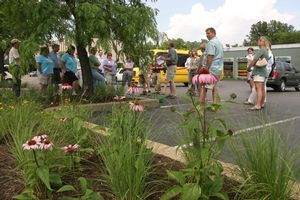
A Grow Native! professional tour visits the Alpine Shop located in downtown Kirkwood. The Alpine Shop landscape features native plants supplied by Bohn's Farm and Greenhouses. (Photo credit: Robert Weaver, The Gateway Gardener Magazine)
Native Plants
Specializing in Native Plants of the Lower Midwest
Bohn's Farm and Greenhouses strives to produce, within a managed production nursery setting, the most extensive selection of Midwest native perennials found in the lower Midwest. Our extensive selection of ecotype species and landscape "nativars" are grown in a variety of container sizes to suit the needs of both the landscape professional and the retail merchant. Special production emphasis in recent years includes native species required for constructing rain gardens, bioswales, and stormwater detention and retension infrastructures according to the "St.Louis County Phase II Stormwater Management Plan" and "Sustainable Practices" adopted by the St. Louis Metropolitan Sewer District (MSD).
Additional Information
Bohn's Farm wishes to extend a sincere thank you to the Shaw Nature Reserve team for their educational assistance to expand our knowledge of native plants via their educational programs and ongoing development and management of The Whitmire Wildflower Garden.
An active member since the inception of the program, Bohn's Farm also values association with the Grow Native! a native plant awareness program jointly managed by the Missori Department of Conservation and Missouri Department of Agriculture.
Bohn's Farm RESPONSIBLE CODE OF CONDUCT: All native plants we offer are propagated from seeds responsibly collected or vegetative cuttings from controlled nursery-produced stock plants. We DO NOT purchase propagated materials from plant material collected in the wild.
Achillea millefoliumYarrow
Achillea millefolium, commonly called common yarrow, is a rhizomatous, spreading, upright to mat-forming perennial that is considered by many to be an aggressive weed. Common yarrow from Europe and Asia was originally introduced to America in colonial times, and has since naturalized throughout the U. S. primarily along roadsides, fields, waste areas and lawns. These species plants are noted for producing deeply-dissected, fern-like, aromatic, medium green foliage and tiny, long-lasting, white flowers that appear in dense, flattened, compound corymbs (to 2-4"across) throughout the summer on stems typically rising 2-3’ tall. Foliage has a strong, somewhat spicy aroma that persists when used in dried arrangements.
[
More Info
]
|
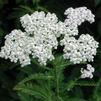
|
Adiantum pedatumFern, Northern Maidenhair
Dainty bright green fronds on shiny black stems create a light, airy texture. Spreads by shallow rhizomes to form a dense groundcover . Thrives in moist, loose, rich soil.
[
More Info
]
|
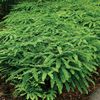
|
Amorpha fruticosaFalse Indigo Bush
Long racemes of purple flower bloom in May and June. Foliage has shrub-like habit and pinnately compound leaves. Grows along stream banks and moist woods.
[
More Info
]
|
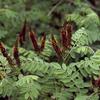
|
Amsonia illustrisBlue Star, Shining
Clusters of pale blue, star-like flowers grace a substantial mound of shiny, leathery leaves in May. Foliage often turns gold in fall. An easy-care native of the Ozarks.
[
More Info
]
|
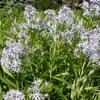
|
Amsonia tabernaemontanaBlue Star
Loose clusters of lilac blue star-shaped flowers bloom in May. Willow like leaves turn a stunning shade of yellow-orange in autumn. Drought tolerant. Easy to grow. Midwest native.
[
More Info
]
|
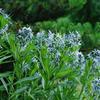
|
Amsonia tabernaemontana 'Storm Cloud'Blue Star
Amsonia tabernaemontana, commonly called bluestar, is a Missouri native herbaceous perennial which occurs most frequently in rich, open woods and thickets in the southwestern part of the State. An erect, clump-forming plant which features terminal, pyramidal clusters of 3/4", soft light blue, star-like flowers in late spring atop erect, leafy stems growing 2-3' tall. Narrow, willow-shaped, dull green foliage may turn an attractive yellow in fall.
‘Storm Cloud’ features near black stems in spring clad with silver-veined dark green leaves. Leaves lighten to olive green by summer. Light periwinkle-blue, star-shaped flowers bloom abundantly from late spring to early summer, often with some rebloom thereafter. Plants typically grow to 24-30" tall spreading to as much as 42" wide.
[
More Info
]
|
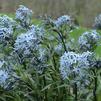
|
Andropogon gerardiiGrass, Big Bluestem
King of native grasses! Blue-green foliage that can reach 8' tall forms distinctive seed heads in late summer. Nice red color in fall. Ideal as a background plant, specimen or in naturalized plantings.
[
More Info
]
|
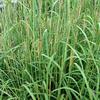
|
Anemone canadensisAnemone, Meadow
A strong growing plant that needs room to move. Clear white single flowers top out at 18" from mid spring to early summer. A robust and competitive native plant that brightens up woodland edges and shady corners of the garden.
[
More Info
]
|

|
Aquilegia canadensisColumbine
Lots of red and yellow nodding flowers for many weeks from late April until mid June. A great source of early nectar for butterflies and hummingbirds. Found naturally on rocky ledges and wooded rocky slopes.
[
More Info
]
|
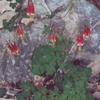
|
Aruncus dioicusGoat'S Beard
Large wands of frothy, creamy white flowers in May and June. Foliage is similar to astilbe but growth habit is shrub-like. A good native for woodland gardens.
[
More Info
]
|
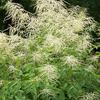
|
Asclepias incarnataMilkweed, Swamp
Clusters of long-lasting vanilla-scented rose-pink flowers are butterfly magnets in July and August. A host plant for Monarch larvae, and a nectar plant for many butterfly species. Grows best in moist soils, but tolerates drier conditions.
[
More Info
]
|
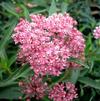
|
Asclepias incarnata 'Cinderella'Milkweed, Swamp
Large 3-4" clusters of fragrant vanilla-scented rose-pink flowers in July and August over lush green foliage attract butterflies and beneficial insects from midsummer to early fall. Grows best in moist soils but tolerant of drier conditions.
[
More Info
]
|
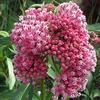
|
Asclepias purpurascensMilkweed, Purple
Asclepias purpurascens, Purple Milkweed looks similar to Common Milkweed (Asclepias syriaca), but the flower color is a rich red purple color compared to the soft gray-pink of Common Milkweed. There are usually one to three blooms that form near the ends of the stems in late spring, early summer.
The flower is held above the leaves on stems a bit longer then Common Milkweed’s and the umbel itself is stiff, and holds a nicely rounded form while that of Common will flop a bit. Blooms can last for about a month and if seed is not set it will occasionally re-bloom. The average height is around 3 feet but it will sometimes go to 4 feet. The flowers will attract a variety of nectar seeking insects from the very small to large Bumble Bees and of course Monarch Butterflies. The leaves are big, around 6-8 inches and they taper to a point at both ends. The mid-vein in the leaves is tinted with the same color as the flower.
Grow Asclepias purpurascens in a site that is well drained but has ample moisture. It seems to prefer a bit of shade but will do well in full sun if it gets deep, regular watering. This Milkweed will not spread aggressively like the Common does. The seed pods are smooth and a little more slender than those of Common Milkweed which has plump pods with a prickly surface.
[
More Info
]
|
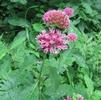
|
Asclepias sullivantiiMilkweed, Sullivant'S
Similar to Common Milkweed but is less aggressive, has slightly smaller flowers, and an overall smooth appearance on the stem, leaves and seed pods. Visited by hummingbirds and a wide variety of bees and butterflies (including, of course, Monarchs), Prairie Milkweed is one of the plants favored by the larvae of the Milkweed Leaf-Miner fly, which bore holes in the leaves.
Bears a very fragrant pink flower, Prairie Milkweed makes a nice addition to any sunny medium to medium-moist garden. After just a few years the taproot will extend very deep, protecting the plant in times of drought, but also making it difficult to move so choose your spot wisely.
[
More Info
]
|
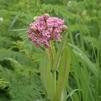
|
Asclepias syriacaMilkweed, Common
This native classic is best known as a food of larval monarch butterflies (along with its siblings A. incarnata and A. tuberosa). Robust and stoloniferous with deep pink clusters of fragrant flowers in June and July, followed by lovely pods of silky seeds in October.Monarch butterflies lay their eggs exclusively on Milkweed plants, making them the sole food source for their larvae. Once found in abundance in nearly every farm field, ditch, and disturbed site, Common Milkweed numbers have been in dramatic decline in recent years, due in part to suburban development and the increased efficiency of herbicides used in conjunction with herbicide-tolerant, genetically modified row crops. Common Milkweed is one of the easiest and fastest to establish of the Milkweeds. The large flower can vary in the color range from nearly white to deep pink-purple. The fragrance is very delicate and pleasing and numerous native pollinators will benefit during its long bloom time.
[
More Info
]
|
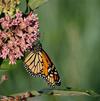
|
Asclepias tuberosaMilkweed, Butterfly
Abundance of bright orange flowers June through August. Host plant for the monarch butterfly and a superior nectar plant for many other butterfly species. Requires well-drained soil.
[
More Info
]
|
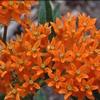
|
Asclepias verticillataMilkweed, Whorled
A widely adaptable and tough native is a deer-resistant food for larval butterflies. The fine-textured foliage provides a dark green backdrop for the clusters of white flowers that appear in June and July. Please note, Asclepias verticillata is highly toxic to livestock and horses - it should not be allowed to take root in pastures or hayfields. Found in dry fields, roadsides and shale barrens, you can see that it needs no coddling. Best located in a sunny dry spot, but will tolerate average to moist garden soil as well.
[
More Info
]
|
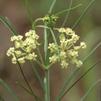
|
Asclepias viridisMilkweed, Spider
Green Milkweed shares with other Asclepias species its milky, irritating sap and strong attractiveness to Monarch butterflies and a host of other insects. Very tolerant of dry conditions, it is also called Green Antelopehorn. Green Milkweed features rose-white flowers surrounded by green that form in showy umbellated clusters, often one per plant. Its beauty and tendency to spread slightly make it a good garden choice. White crab spider lives on this plant.
[
More Info
]
|
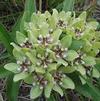
|
Aster (syn Symphyotrichum) novae-angliaeAster, New England
Blooms August and September. AKA Symphyotrichum novae-angliae.
[
More Info
]
|
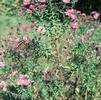
|
Aster (syn Symphyotrichum) novae-angliae 'Purple Dome'Aster, New England
Heavy blooming with deep purple flowers late July or early August and continuing through September and October. Densely compact mounded growth habit. While this plant may appear leggy in a container on the retail shelf, Purple Dome exhibits outstanding landscape performance and still offers the richest purple flower among all Asters. AKA Symphyotrichum novae-angliae.
[
More Info
]
|
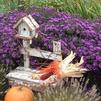
|
Aster (syn Symphyotrichum) oblongifoliusAster, Aromatic
A charming native with masses of blue-purple daisy like flowers blooming July through frost. Blue-green foliage forms tidy, compact, self-supporting mound and is aromatic when crushed. Neat, dome-shaped habit. AKA Symphyotrichum oblongifolium.
[
More Info
]
|
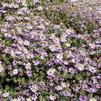
|
Aster (syn Symphyotrichum) oolentangiensisAster, Sky Blue
Dozens of blue flowers with yellow centers bloom in September and October. The foliage is blue-green and stems are dark. Butterflies love the nectar. AKA Symphyotrichum oolentangiense.
[
More Info
]
|
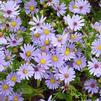
|
Athyrium filix-feminaFern, Lady
Bright green, lacy fronds arise from creeping rhizomes. Clumps are dense and upright. Vigorous and easy to grow.
[
More Info
]
|
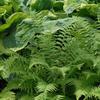
|
Athyrium filix-femina 'Lady in Red'Fern, Lady
Vibrant burgundy stems stand out against light green lacy fronds. Foliage is upright and arching. Naturalizes by creeping rhizomes.
[
More Info
]
|

|
